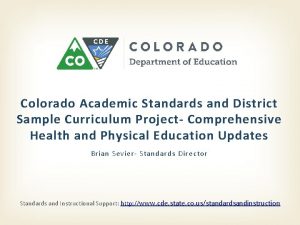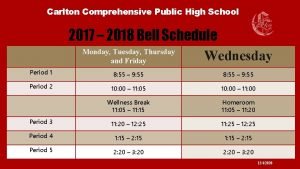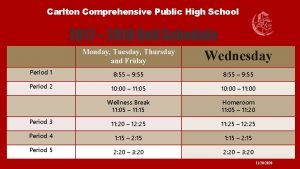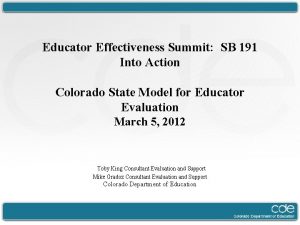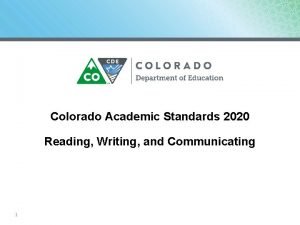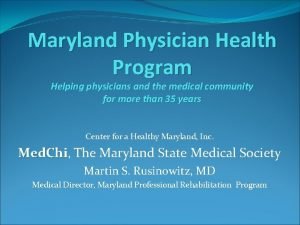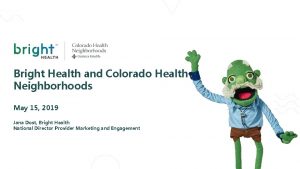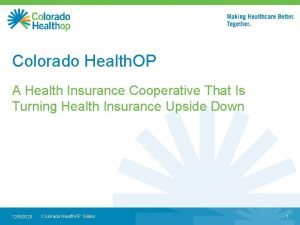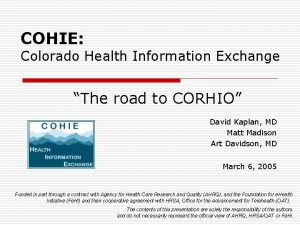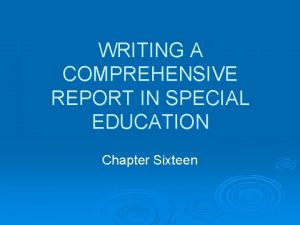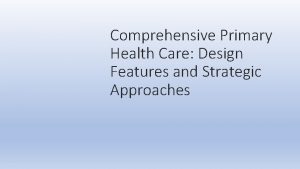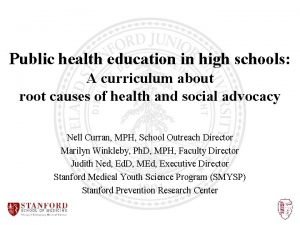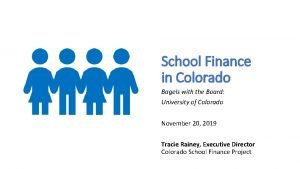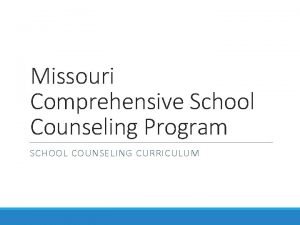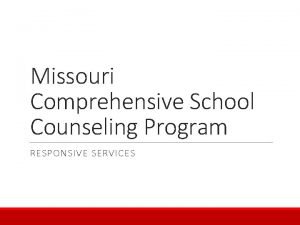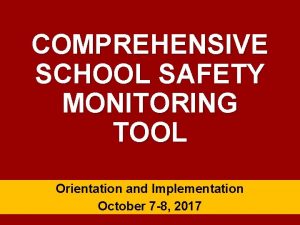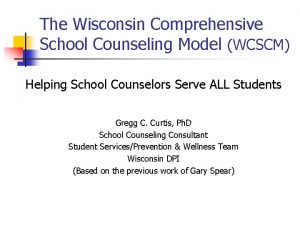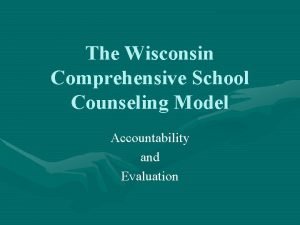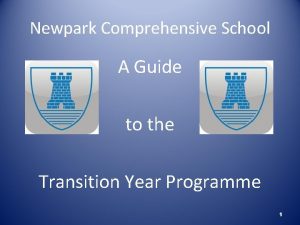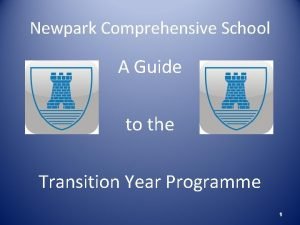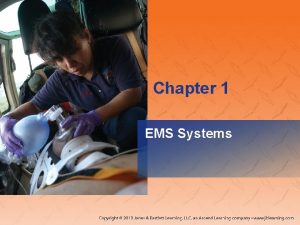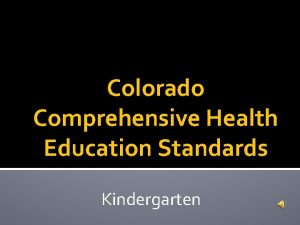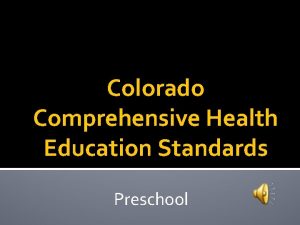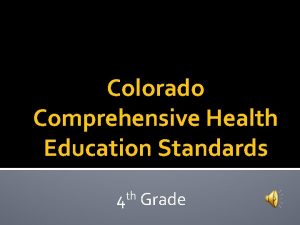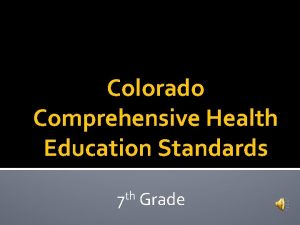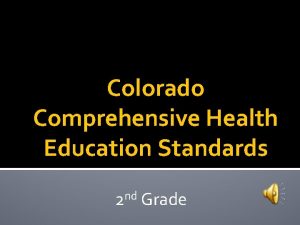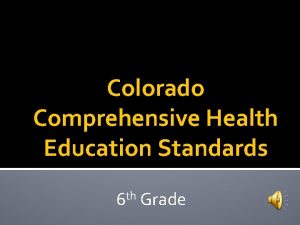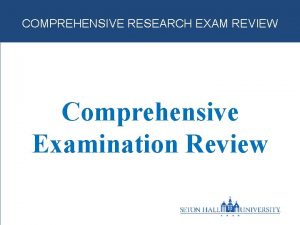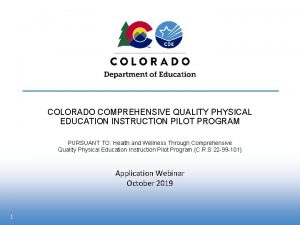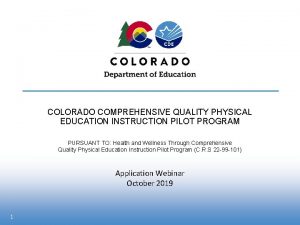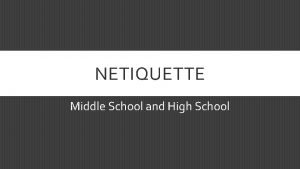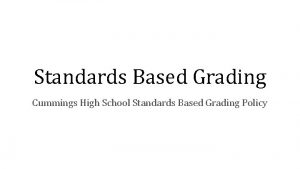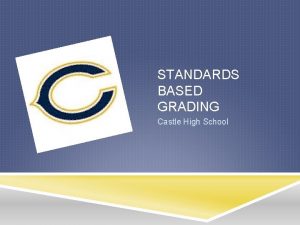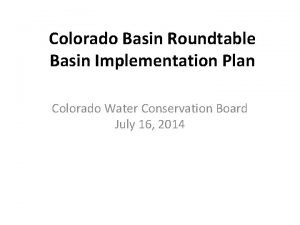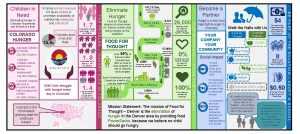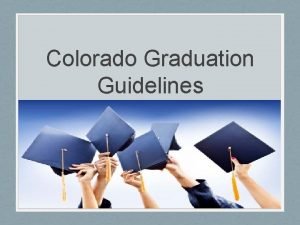Colorado Comprehensive Health Education Standards High School Comprehensive

































- Slides: 33

Colorado Comprehensive Health Education Standards High School

Comprehensive Health Education Standards �Physical & Personal Wellness �Emotional & Social Wellness �Prevention & Risk Management

Physical & Personal Wellness �Prepared Graduate Competencies Participate regularly in physical activity Achieve and maintain a health-enhancing level of physical fitness Apply knowledge and skills to engage in healthy eating Apply knowledge and skills necessary to make personal decisions that promote healthy relationships and sexual and reproductive health Apply knowledge and skills related to health promotion, disease prevention, and health maintenance

STANDARD: Physical and Personal Wellness Grade Level Expectations 1. Analyze the benefits of a health diet and the consequences of an unhealthy diet. 2. Analyze how family, peers, media, culture, and technology influence healthy eating choices. 3. Demonstrate ways to take responsibility for life long healthy eating. 4. Use decision-making process to make healthy decisions about relationships and sexual health. 5. Support others in making positive and healthful choices about sexual activity. 6. Develop and maintain the ongoing evaluation of factors that impact health, and modify lifestyle accordingly.

STANDARD: Physical and Personal Wellness Grade Level Expectations 1. Analyze the benefits of a healthy diet and consequences of an unhealthy diet Prepared Graduates: Apply knowledge and skills to engage in lifelong healthy eating. Evidence Outcomes: Students can: a) Use nutritional evidence to describe healthy and unhealthy diets b) Analyze and describe relationship among healthy eating, physical activity, and chronic diseases such as heart disease, cancer, type-2 diabetes, hypertension, and osteoporosis. c) Describe the importance of eating a variety of foods to balance nutrient and caloric needs d) Explain the effects of eating disorders on healthy growth and development e) Analyze the relationship between eating behavior and metabolism

STANDARD: Physical and Personal Wellness Grade Level Expectations 2. Analyze how family peers, media, culture, and technology influence healthy eating choices Prepared Graduates: Apply knowledge and skills to engage in life long healthy eating Evidence Outcomes: Students can: a) Analyze advertising claims for nutrition supplements and weight loss products. b) Analyze how family, peers, and the media influence food choices c) Analyze the influence of media on the selection of products and services related to weight management d) Analyze the influence of family, peers, culture, and the media on body image and the subsequent effects on eating behavior e) Analyze how a positive or negative body image can influence eating behavior

STANDARD: Physical and Personal Wellness Grade Level Expectations 3. Demonstrate ways to take responsibility for healthy eating. Prepared Graduates: Apply knowledge and to engage in life long healthy eating Evidence Outcomes: Students can: a) Describe and explain how current and federal nutrition guidelines are useful in planning a healthy diet. b) Use information on food labels to make healthy eating choices c) Demonstrate how to balance caloric intake with caloric expenditure to maintain, gain, or reduce weight in a healthy manner. d) Set a goal to improve one’s personal food choices that lead to a healthier diet.

STANDARD: Physical and Personal Wellness Grade Level Expectations 4. Use a decision-making process to make healthy decisions about relationships and sexual health Prepared Graduates: Apply knowledge and skills necessary to make personal decisions that promote healthy relationships and sexual and reproductive health. Evidence Outcomes: Students can: a) Define the characteristics of healthy relationships, dating, committed relationships, marriage, and family. b) Analyze the possible consequences of early sexual activity and the emotional, mental, social, and physical benefits for delaying sexual activity c) Describe how a person can choose to abstain from sexual activity at any point, even after having engaged in prior sexual activity. d) Analyze factors that influence the choice, use, and effectiveness of contraception, including the availability of contraception methods

STANDARD: Physical and Personal Wellness Grade Level Expectations Evidence Outcomes Continued: Students can: e) Explain the difference between risk avoidance and risk seduction and strategies one can utilize for each as it relates to STD’s and pregnancy f) Analyze when it is necessary to seek help with or leave an unhealthy situation g) Evaluate how HIV/AIDS and other sexually transmitted diseases or pregnancy could impact life goals h) Examine the responsibilities of parenthood i) Appraise internal and external influences and pressures to become sexually active, and demonstrategies to resist those pressures.

STANDARD: Physical and Personal Wellness Grade Level Expectations 5. Support others in making positive and healthful choices about sexual activity. Prepared Graduates: Apply knowledge and skills necessary to make personal decisions that promote healthy relationships and sexual and reproductive health. Evidence Outcomes: Students can: a) Demonstrate ways to encourage friends to remain sexually abstinent or return to abstinence if sexually active b) Communicate the benefits of avoiding or reducing the risk of unwanted pregnancy and sexually transmitted diseases, including HIV c) Communicate the importance of HIV and sexually transmitted disease testing and counseling to those who are sexually active

STANDARD: Physical and Personal Wellness Grade Level Expectations 6. Develop and maintain the ongoing evaluation of factors that impact health, and modify lifestyle accordingly. Prepared Graduates: Apply knowledge and skills necessary to make personal decisions that promote healthy relationships and sexual and reproductive health. Evidence Outcomes: Students can: a) Analyze the role of personal responsibility in maintaining and enhancing personal, family, and community wellness b) Debate the social and ethical implications of the availability and use of technology and medical advances to support wellness c) Explain the importance of health screenings, immunizations, and checkups, including screenings and examinations that are necessary to maintain healthy living.

Emotional & Social Wellness �Prepared Graduate Competencies Utilize knowledge and skills to enhance mental, emotional, and social well being Exhibit responsible personal and social behavior that respects self and others

STANDARD: Emotional & Social Wellness Grade Level Expectations 1. Analyze the interrelationship of physical, mental, emotional, and social health. 2. Set goals, and monitor progress on attaining goals for future success. 3. Advocate to improve or maintain positive mental and emotional health for self and others.

STANDARD: Emotional & Social Wellness Grade Level Expectations 1. Analyze the interrelationship of physical, mental, emotional, and social health. Prepared Graduates: Utilize knowledge and skills to enhance mental, emotional, and social well-being Evidence Outcomes: Students can: a) Analyze the characteristics of a mentally and emotionally healthy person b) Describe how mental and emotional health can affect health-related behaviors c) Evaluate effective strategies for dealing with stress d) Analyze the causes, symptoms, and effects of depression and anxiety.

STANDARD: Emotional & Social Wellness Grade Level Expectations 2. Set goals, and monitor progress on attaining goals for future success. Prepared Graduates: Utilize knowledge and skills to enhance mental, emotional, and social well-being Evidence Outcomes: Students can: a) Analyze why setting a personal goal contributes to mental and emotional wellness b) Define a clear, attainable personal goal c) Describe steps needed to reach personal goals.

STANDARD: Emotional & Social Wellness Grade Level Expectations 3. Advocate to improve or maintain positive mental and emotional health for self and others. Prepared Graduates: Utilize knowledge and skills to enhance mental, emotional, and social well-being Evidence Outcomes: Students can: a) Demonstrate effective and respectful advocacy strategies in support of the needs and rights of others b) Demonstrate support and respect for diversity c) Advocate for positive and respectful school environment that supports prosocial behavior d) Demonstrate how to communicate the importance of seeking help for mental and emotional problems.

Prevention & Risk Management �Prepared Graduate Competencies Apply knowledge and skills to make health- enhancing decisions regarding the use of alcohol, tobacco, and other drugs Apply knowledge and skills that promote healthy, violence free relationships Apply personal safety knowledge and skills to prevent and treat intentional or unintentional injury

STANDARD: Prevention & Risk Management Grade Level Expectations 1. The impact of individuals’ use of nonuse of alcohol or other drugs. 2. Analyze the factors that influence a person’s decision to use or not use alcohol, tobacco, and other drugs 3. Develop interpersonal communication skills to refuse or avoid alcohol, tobacco, and other drugs 4. Develop self-management skills to improve health by staying tobacco, alcohol, and other drug free. 5. Analyze the factors that influence community and societal beliefs that underlie violence, and describe relationships, attitudes, behavior, and vulnerability to violence.

STANDARD: Prevention & Risk Management Grade Level Expectations 6. Analyze the underling causes of self-harming behavior, harming others, and steps involved in seeking help. 7. Identify the emotional and physical consequences of violence, and find strategies to deal with, prevent, and report them 8. Access valid information and resources that provide information about sexual assault and violence. 9. Demonstrate verbal and nonverbal communication skills and strategies to prevent violence 10. Advocate for changes in the home, school, or community that would increase safety.

STANDARD: Prevention & Risk Management Grade Level Expectations 1. Analyze the impact of individuals’ use of nonuse of alcohol or other drugs. Prepared Graduates: Apply knowledge and skills to make health-enhancing decisions regarding the use of alcohol, tobacco, and other drugs Evidence Outcomes: Students can: a) Analyze the healthy alternatives to substance use b) Predict the potential effects of an individual’s substance abuse on others c) Analyze the consequences of using weight-loss pills and performance enhancing drugs. d) Analyze the relationship between using alcohol and other drugs as wells as other health risks such as unintentional injuries, violence, suicide, sexual activity and tobacco use e) Describe the harmful effects of binge drinking

STANDARD: Prevention & Risk Management Grade Level Expectations 2. Analyze the factors that influence a person’s decision to use or not use alcohol, tobacco, and other drugs Prepared Graduates: Apply knowledge and skills to make health-enhancing decisions regarding the use of alcohol, tobacco, and other drugs Evidence Outcomes: Students can: a) Evaluate strategies for managing the impact of internal and external influences on alcohol, tobacco, and other drug use. b) Analyze the role of individual, family, community, and cultural norms on the use of alcohol, tobacco, and other drugs. c) Describe the financial, political, social, and legal influences on the use of alcohol, tobacco, and other drugs

STANDARD: Prevention & Risk Management Grade Level Expectations 3. Develop interpersonal communication skills to refuse or avoid alcohol, tobacco, and other drugs Prepared Graduates: Apply knowledge and skills to make health-enhancing decisions regarding the use of alcohol, tobacco, and other drugs Evidence Outcomes: Students can: a) Demonstrate verbal and nonverbal ways to refuse alcohol, tobacco, and other drugs b) Demonstrate effective negotiating skills to avoid riding in a car with someone who has been using alcohol or other drugs c) Demonstrate effective persuasion skills that encourage friends and family not to use alcohol, tobacco, and other drugs

STANDARD: Prevention & Risk Management Grade Level Expectations 4. Develop self-management skills to improve health by staying tobacco, alcohol, and other drug free. Prepared Graduates: Apply knowledge and skills to make health-enhancing decisions regarding the use of alcohol, tobacco, and other drugs Evidence Outcomes: Students can: a) Develop a personal plan to improve health by staying free of alcohol, tobacco, and other drugs. b) Demonstrate the ability to monitor personal behavior related to alcohol or other drug use, including sexual activity and other risky behaviors c) Make a personal commitment to avoid situations that put a person at risk due to the presence of alcohol and other drugs d) Predict how a drug-free lifestyle supports the achievement of short and long term goals

STANDARD: Prevention & Risk Management Grade Level Expectations 5. Analyze the factors that influence community and societal beliefs that underlie violence, and describe relationships, attitudes, behavior, and vulnerability to violence. Prepared Graduates: Develop self-management skills to healthy and violence free relationships Evidence Outcomes: Students can: a) Demonstrate tolerance for individual differences b) Analyze the consequences of prejudice, discrimination, bias, racism, sexism, and hate crimes c) Analyze situations that could lead to different types of violence such as bullying, verbal abuse, hazing, physical assault and fighting, dating violence, acquaintance rape, sexual assault, and family violence d) Demonstrate the ability to take the perspectives of others in a conflict situation

STANDARD: Prevention & Risk Management Grade Level Expectations 6. Analyze the underling causes of self-harming behavior, harming others, and steps involved in seeking help. Prepared Graduates: Develop self-management skills to healthy and violence free relationships Evidence Outcomes: Students can: a) Analyze the signs and symptoms of people who are in danger of harming themselves or others b) Explain how self-directed violence is the result of the accumulation of multiple problems rather than just one problem c) Summarize why it is important to tell an adult if there are people who are in danger of harming themselves or others

STANDARD: Prevention & Risk Management Grade Level Expectations 7. Identify the emotional and physical consequences of violence, and find strategies to deal with, prevent, and report them Prepared Graduates: Develop self-management skills to healthy and violence free relationships Evidence Outcomes: Students can: a) Analyze how power and control differences in relationships such as peer, dating, or family relationships can contribute to aggression and violence b) Analyze situations that could lead to pressure to have sex c) Summarize why individuals have the right to refuse sexual contact d) Analyze situations that could lead to pressure to have sex e) Analyze how media messages normalize violence f) Explain the risks associated with choosing friends who use substances and violence to solve problems

STANDARD: Prevention & Risk Management Grade Level Expectations 8. Access valid information and resources that provide information about sexual assault and violence. Prepared Graduates: Develop self-management skills to healthy and violence free relationships Evidence Outcomes: Students can: a) Demonstrate the ability to access resources such as rape crisis centers that provide accurate information about sexual assault and sexual violence b) Demonstrate the ability to locate reliable school and community resources to assist with problems related to violence.

STANDARD: Prevention & Risk Management Grade Level Expectations 9. Demonstrate verbal and nonverbal communication skills and strategies to prevent violence Prepared Graduates: Develop self-management skills to healthy and violence free relationships Evidence Outcomes: Students can: a) Demonstrate verbal and nonverbal ways to ask for help from a parent, other trusted adult, or friend when there are pressures to engage in violence b) Demonstrate verbal and nonverbal ways to refuse pressure to engage in violence c) Demonstrategies that could be use to prevent a conflict from starting or escalating d) Demonstrate effective strategies for resolving conflicts with another person in nonviolent ways e) Demonstrate verbal and nonverbal ways to prevent hazing

STANDARD: Prevention & Risk Management Grade Level Expectations 10. Advocate for changes in the home, school, or community that would increase safety. Prepared Graduates: Apply safety knowledge and skills to prevent and treat unintentional injury Evidence Outcomes: Students can: a) Determine situations and environments that could lead to unsafe risks that cause injuries b) Explain ways to reduce the risk of injuries while biking or driving motor vehicles such as automobiles, snowmobiles, and jet skis including cell phone and use texting c) Advocate for others not to use alcohol or other drugs when biking, driving, or riding in a car d) Advocate for changes at home, in school, or in the community that would increase safety, such as testing smoke detectors, implementing a fire escape plan, and erecting fencing around swimming pools

Comprehensive Health Education STANDARD: Physical & Personal Wellness Emotional & Social Wellness Prevention & Risk Management High School at a Glance GRADE LEVEL EXPECTATIONS Healthy Eating Decision Making Regarding Sexual Health Supporting Others Making Healthy Choices Ongoing Self Health Evaluations Interrelationship of Physical, Mental, Emotional Health Goal Setting Healthy Relationships Drug and Alcohol Use Prevention Violence Preventio

Academic Standards Template GRADE LEVEL EXPECTATION: Skills & concepts students at this grade should master in progress toward graduation STANDARD: One of 3 PREPARED GRADUATE COMPETENCY What students will be able to do when they graduate. INQUIRY QUESTIONS: Promote critical thinking EVIDENCE OUTCOMES: Indicators of student mastery NATURE OF HEALTH: Characteristics of discipline RELEVANCE & APPLICATION: Relevant societal context

HOW ARE YOU ABLE TO DO THIS WITHOUT A DEDICATED HEALTH CLASS? u o y e ng r A eli fe Overwhelmed Content Integration 1. Familiarize yourself with the standards. 2. Find ways to integrate the standards into other academic disciplines. 3. Make healthy messages a part of your classroom culture. 4. Utilize the language of health education throughout the school day. 5. Encourage the use of skills learned through health education in your classroom. 6. Utilize the resources at http: //colegacy. org/comprehensive-pe-and-healthstandards/teach-it/ and at http: //www. cde. state. co. us/sitoolkit/ for ideas for teaching health education and for integrating health education into other content areas. 7. Access the help of your health education coordinators.

Thank you & Evaluation We are preparing students to be successful in life! Please take the post-test at the link below: https: //www. surveymonkey. com/s/YSHKBZ 5
 Colorado physical education standards
Colorado physical education standards Carlton high school bell schedule
Carlton high school bell schedule Carlton comprehensive high school math
Carlton comprehensive high school math Carlton comprehensive high school
Carlton comprehensive high school Colorado principal quality standards
Colorado principal quality standards Colorado academic standards 2020
Colorado academic standards 2020 Colorado model content standards
Colorado model content standards Health standards section
Health standards section Differences between health education and physical education
Differences between health education and physical education Health propaganda definition
Health propaganda definition Maryland physician health program
Maryland physician health program Bright health centura
Bright health centura Colorado health op
Colorado health op Colorado health information exchange
Colorado health information exchange Cphp
Cphp Comprehensive report writing
Comprehensive report writing Comprehensive primary health care definition
Comprehensive primary health care definition Health education topics for primary school students
Health education topics for primary school students Colorado springs school districts
Colorado springs school districts Colorado association of school business officials
Colorado association of school business officials Casbo colorado
Casbo colorado Risley middle school pueblo co
Risley middle school pueblo co Crescenta valley high school summer school
Crescenta valley high school summer school Haltom high school summer school
Haltom high school summer school Factors necessary for appropriate service standards
Factors necessary for appropriate service standards Missouri counseling lessons
Missouri counseling lessons Responsive services school counseling
Responsive services school counseling Hebburn comp uniform
Hebburn comp uniform School safety monitoring
School safety monitoring Wisconsin comprehensive school counseling model
Wisconsin comprehensive school counseling model Wisconsin comprehensive school counseling model
Wisconsin comprehensive school counseling model Newpark comprehensive school
Newpark comprehensive school Newpark comprehensive school fees
Newpark comprehensive school fees National ems standards
National ems standards
